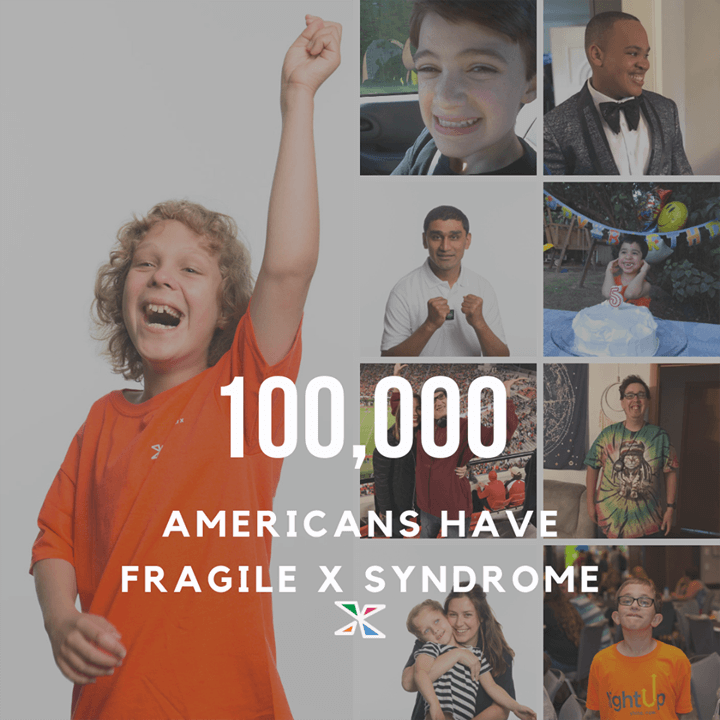Many of us across the country have been waiting for summer to finally appear. We celebrate the Fourth of July with fireworks and festivals, to raise awareness of our freedom and welcome summer. Did you know that July is Fragile X Month, with July 22
nd designated as Fragile X Awareness Day?
1 Fragile X is the leading cause of inherited intellectual disability. It can also be associated with other health problems in both men and women who carry a Fragile X mutation but have normal intelligence.

Image courtesy of FragileX.org (https://fragilex.org)
Fragile X syndrome is more common in boys, but girls can also inherit the conditionFragile X syndrome got its name from the test result that was first used to diagnose it. When the blood from affected individuals was subjected to certain conditions and then analyzed for chromosomes, a part of their X chromosome looked like it was hanging off, broken, or “fragile”.Fragile X is caused by an altered gene on the X chromosome called
FMR1. Most girls have two X chromosomes and most boys have one X and one Y chromosome. Fragile X syndrome is an X-linked condition because the gene resides on the X chromosome. Fragile X syndrome is usually passed from a carrier or affected mother to her child. Since boys only have one X chromosome, they tend to have more severe symptoms if they inherit the altered gene compared to girls who have two X chromosomes. Unlike many X-linked conditions, however, girls can also be affected if they inherit this altered gene.
Fragile X is caused by a triplet repeat mutation in the FMR1 geneThe underlying genetic cause of Fragile X was discovered in the 1991.
2,3,4 The type of DNA change in the gene is known as an expanded triplet repeat. This triplet repeat can be present in different sizes and explains the wide variety of symptoms that we can see in people who carry a mutation. Now that the DNA change is understood, testing for Fragile X is performed by DNA analysis instead of chromosome analysis.
There are three separate conditions caused by an altered FMR1 gene - Fragile X syndrome (FXS): Boys, and less frequently girls, are affected with a range of intellectual disabilities and behavioral challenges, including autistic behaviors, attention deficit disorder, and attention deficit hyperactivity disorder, as well as some characteristic physical features that would be recognized by a physician.
- Fragile X-Associated Tremor-Ataxia syndrome (FXTAS): These are symptoms of uncontrolled tremor, balance difficulties, and memory problems. They occur in otherwise unaffected individuals, usually after the age of 50 years.
- Fragile X-Associated Primary Ovarian Insufficiency (FXPOI): This refers to a range of ovarian function problems including infertility and early menopause in otherwise unaffected women younger than the age of 40 years.
What is the risk of being a carrier?Since Fragile X syndrome is inherited, there may be characteristics in a family that indicate whether or not there is risk of carrying this altered gene. If someone is pregnant, or planning to become pregnant, they may wish to know if the risk for a child affected with Fragile X syndrome is increased. Do they have relatives with intellectual disabilities, autism spectrum disorders, or other behavioral disorders? Are there any female relatives with early or premature menopause? Are there any relatives with later onset neurological findings of tremors, memory loss, or personality or psychiatric changes? If so, there may be an increased risk and carrier screening for Fragile X is an option to get more information.For more information about Fragile X, FXTAS and FXPOI, please visit the website:
www.fragilex.org.For information about the research being done to treat or cure Fragile X:
www.fraxa.org.
5References1. National Fragile X Foundation website https://fragilex.org.2. Oberle I, et al. Instability of a 550-base pair DNA segment and abnormal methylation in fragile X syndrome. Science. 1991;252:1097-1102.3. Verkerk AJMH, et al. Identification of a gene (FMR-1) containing a CGG repeat coincident with a breakpoint cluster region exhibiting length variation in fragile X syndrome. Cell,1991;65:905-914.4. Yu S, et al. Fragile X genotype characterized by an unstable region of DNA. Science, 1991;252:1179-1181.5. FRAXA Research Foundation. fraxa.org.
Your Privacy Choices





